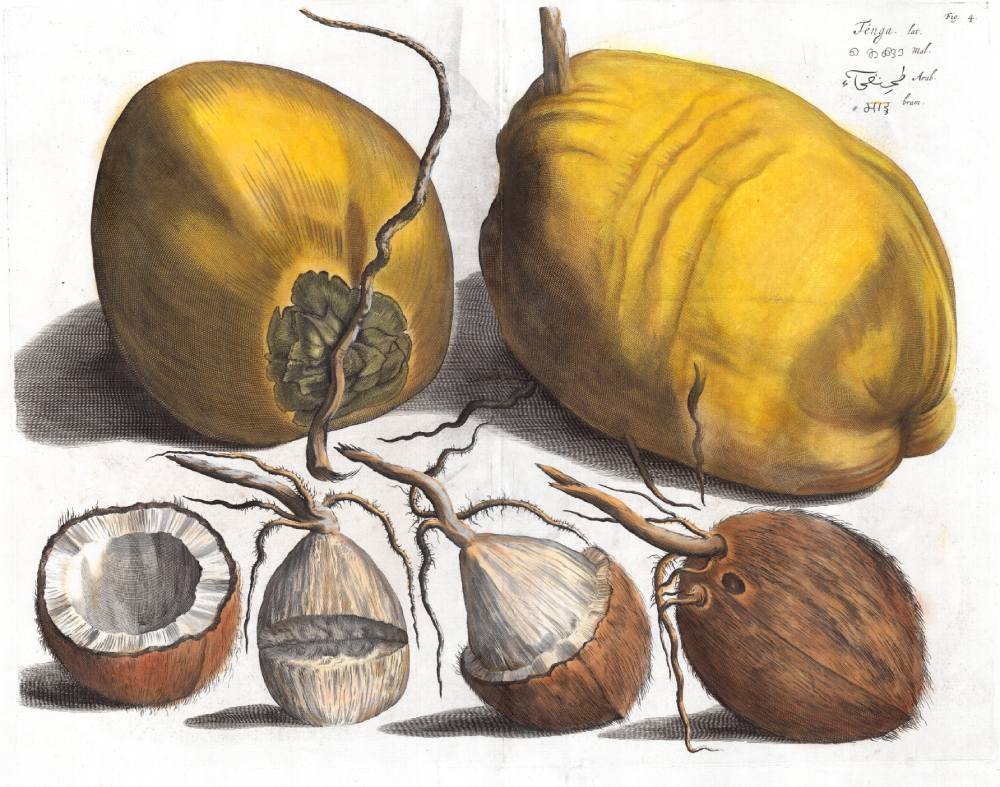
Indonesia is known for its vibrant markets which boast a rich variety of fruits, or ‘buah’. From luscious mangosteens to spiky durian, fruits play an important part in Indonesian cuisine. While Indonesians have cherished these delights for centuries, it was the first European explorers and botanists who introduced these exotic fruits to the rest of the world. Sake Santema, owner of Indies Gallery, delves into the world of antique botanical prints featuring Indonesian fruits, showcasing a few treasures from his collection.
Prior to the development of greenhouses during the 17th and 18th centuries, paintings and drawings were really the only references to exotic ‘Far East’ fruits for Europeans. However, early depictions of fruits suffered from inaccuracies, as they were often sketched from memory. Transporting fresh fruit back to Europe by ship proved impractical, as the return journey alone took approximately 200 days, and dried spices were the only botanical goods that could withstand the journey home.
Later, the Dutch East Indies Company (VOC) recognised the value of indigenous medicinal plants for the treatment of tropical diseases, which led to better efforts to document tropical plants in detail. One of these detailed publications is Hortus Malabaricus (Garden of Malabar), published in the year 1678 in Amsterdam, one of the earliest published works on the flora of Southeast Asia, with over 700 plants described with titles in Latin, Sanskrit, Arabic and Malayalam.
Of course, most fruits are now known across the world, but there is a handful that remains relatively obscure beyond the borders of Indonesia. This is primarily due to the challenges of cultivating them outside of tropical regions and their short shelf life, lasting only a few days after being harvested. Among these treasures are the Durian and Mangosteen, affectionately referred to as the ‘King and Queen of Fruits’.
Hoola van Nooten was a Dutch botanical artist who travelled to the island of Java with her brother, a successful merchant in the sugar business. During her time in Java, she taught drawing lessons and became captivated by the indigenous flora, leading her to create a series of drawings, eventually culminating in 40 plates showcasing various fruit and flower species from Java. In 1863, the work was published in Europe, with a dedication to Sophia Mathilde, wife of King William III of the Netherlands, the patron of Hoola van Nooten’s works. Despite the book’s multiple print editions, Hoola van Nooten passed away in the year 1892 in poverty at the age of 74 in Tanah Abang, Batavia (Jakarta).


The Durian, or ‘King of Fruits’, originates in Borneo, Sumatra and Malaya and holds a revered position in Indonesia. Even before the colonial era, there was a trading network for this intensely flavoured fruit. The term ‘Durian’ is derived from the Malay language, meaning ‘thorny one’, and its earliest known mention can be traced back to the Old Javanese Kakawin Rāmāyaṇa, written between 856 and 930. The first recorded European reference to the Durian can be found on a world map created by an Italian monk around the year 1450. There it mentions a passage from the travel accounts of a Venetian merchant who explored the Indian Ocean region in the early fifteenth century.
The Mangosteen, or ‘Queen of Fruits’, is believed to originate from the Moluccas and Sunda Islands of Indonesia. Her first appearance in European botany documents dates back to 1753 when a Swedish botanist included her in his ‘Species Plantarum’. The Mangosteen owes her nickname ‘Queen of Fruits’ to English Queen Victoria (1819-1901), and legend has it that she promised a Royal Knighthood to anyone who brought her back a pristine mangosteen from their voyages. The fruit was introduced into European greenhouses in 1855, but does not grow well outside the tropics. Despite being praised for her rosy smell and simultaneously sweet and sour taste, mangosteen’s cultivation rarely goes outside of tropical borders. Even with the aid of modern refrigerated transport – as in less than a week after leaving the trees the fruit pulp melts away to a brown mass.
The antique fruit prints shown in this article are offered for purchase by Indies Gallery, dealer in authentic maps, prints, books and photographs, dating from the fifteenth to the twentieth century. www.indiesgallery.com
Indies Gallery also offers these decorative artworks as reprints. You will find these at www.oldeastindies.com






